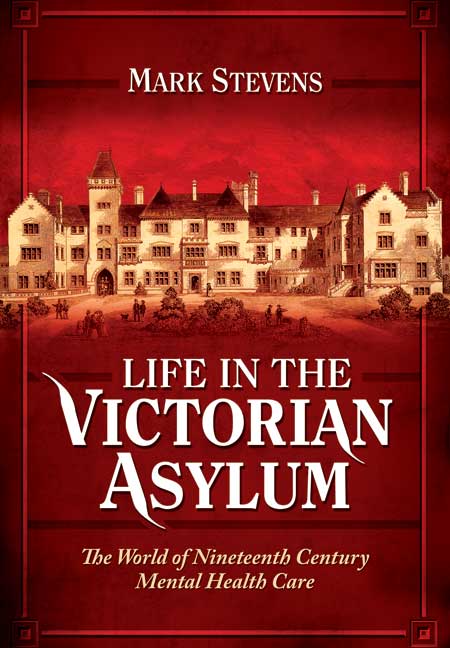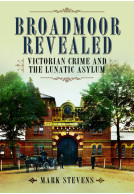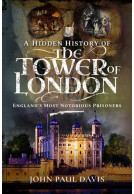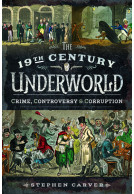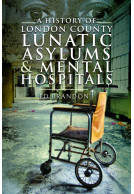Life in the Victorian Asylum (ePub)
The World of Nineteenth Century Mental Health Care
Imprint: Pen & Sword History
File Size: 6.9 MB (.epub)
Pages: 176
Illustrations: 25 black and white illustrations
ISBN: 9781473842380
Published: 22nd October 2014
Interview with Mark Stevens
Life in the Victorian Asylum reconstructs the lost world of the nineteenth century public asylums. This fresh take on the history of mental health reveals why county asylums were built, the sort of people they housed and the treatments they received, as well as the enduring legacy of these remarkable institutions.
Mark Stevens, the best-selling author of Broadmoor Revealed, is a professional archivist and expert on asylum records. In this book, he delves into Victorian mental health archives to recreate the experience of entering an asylum and being treated there, perhaps for a lifetime.
Praise for Broadmoor Revealed
'Superb,' Family Tree magazine
'Detailed and thoughtful,' Times Literary Supplement
'Paints a fascinating picture,' Who Do You Think You Are? magazine
This is a sobering look at Victorian Asylums. I liked the style of the beginning, where it is written as though you are an incoming patient and the book is your manual. It's a stark reminder that mental illness has always been handled in the wrong ways, and while we have come a long way, we still have a long way to go.
NetGalley, Morris Morgan
This fascinating, and often disturbing, book illustrated how easy it was to be committed to an asylum. The treatments that patients were subjected to so early on in our understanding of mental health care with nothing short of barbaric.
NetGalley, John Dixon
This didn't feel to me to be a book you would read in one sitting, but more of something you would dip in and out of as you go.
Review by Cara Dobbing
Fortean Times 403
... a good introduction to the Victorian lunatic asylum, with the added advantage of some great contemporary illustrations.
Rating: 5 out of 5 stars
NetGalley, Sophie Whiting
This was absolutely brilliant - it was really insightful and it contained everything I'd imagine from this type of book. If your into the Victorian Era, this is a must read. It makes you question why they were built and why they used the practices today and has it had an impact on the way we deal with mental health in the 21st century.
Rating: 5 out of 5 stars
NetGalley, Wendy M Rhodes
A very well written account of life in the Victorian Asylum-an interesting subject-sad in places-so glad society no longer applies the same practices.
Rating: 5 out of 5 stars
NetGalley, Jackie Shephard
This book was extremely fascinating as well as educational. Mental health awareness is extremely important even today. This book shows us how far we have come and yet more on how much to this day we need to learn from to make more strides. I really appreciated the authors details as sad as parts were to read at times I think everyone must read this!
What a clever, accessible read by a knowledgeable author! I really enjoyed this read and learning so much by a very thorough journey through a Victorian mental asylum.
NetGalley, Damaris Bredin
What a fascinating quick read! It was written like a manual for new patients into the insane asylum in the first half and then gave facts about victorian insane asylums in the 2nd half. Very well researched and the writing drew you in and kept you enthralled. Nice little historical book.
NetGalley, Vonda Svara
I’m a little obsessed with the Victorian period. I also have a personal interest in mental health. To have the two combined I knew I had to read it. I was not disappointed. It was an interesting quick read.
NetGalley, Jamie Sutch
4 "elegant, accessible, smooth" stars !!
NetGalley, Jaidee Deableau
Thank you to Netgalley, Pen and Sword History and the author for an e-book copy in exchange for my honest review. This book was first published in 2014 and re-released July 2020.
Mr. Stevens is an archivist by profession and has written an excellent social history of a Victorian asylum in England. The name was Moulsford Asylum with some secondary information from nearby Broadmoor Asylum. Many people have a skewed understanding of the history of the care of the severely mentally ill and think of Bedlam in London with crowded, cruel and archaic treatments. This book lays some of these myths to rest and takes us through how the poor mentally ill could receive very good care in comfortable surrounding with compassionate staff through the moral treatment or the use of work and leisure to help those afflicted with severe conditions.
Mr. Stevens acknowledges that the care was paternalistic but in many ways it seems superior to the release of many severely ill into homeless shelters and prison that often happen today.
Mr. Stevens writes elegantly, accessibly and imparts a great deal of information about political history, social history, architecture, early psychiatry and interpersonal relations. Initially he writes as if it were a patient handbook although the depth of information make it more akin to an employee's handbook. He then goes on to describe larger social forces and gives a few brief case histories.
All in all, I found this to be a most informative and measured read. Thank you Mr. Stevens !
Takes you on a trip like you are going into the asylum from coming into staying there for a short term or long term. What start to finish is like. It is interesting for those who look in the history of mental health/care.
NetGalley, Alexandra Roth
I am glad I took the opportunity to read this book, because it is an accessible, well researched and engaging read full of fascinating information. It also dispels some of the myths about asylums, but I won't spoil it for you!
NetGalley, Carolyn Farrell
Highly recommended to anyone with an interest in psychiatry, social history, or the Victorian era, and interested in reading about it from a different angle.
Rating: 5 out of 5 stars
NetGalley, Cristie Underwood
As someone that is interested in Psychology, I enjoyed learning about what mental health treatment was like in the Victorian Age. Many of the patients spent their lives in asylums and were not treated cruelly, as is the general opinion of many. The author highlights the ways that these institutions paved the way for better and more humane care.
Rating: 5 out of 5 stars
NetGalley, Karen Meeus
The author presents his facts in a highly original format, addressing the reader/prospective mental patient from the perspective of a Victorian asylum, clearly outlining the raison d’être, management and day-to-day realities of such a place. It reads very much like an extensive manual or a welcome brochure. As we get our information from the 19th century perspective, what I missed a little was the comparison or addition of contemporary insights regarding certain topics. On the whole though, I thought it was very enlightening, and I was struck by the benevolent and earnest principles that lay at the heart of the care for mental health patients in (mostly the latter half of) the 19th century, which the author took great pains to illustrate. It was very different, of course, both from a medical and societal point of view, than it is today but it appears that they did have their patients best interests in mind whereas I had expected a much grimmer and uncaring outlook, perhaps more in line with the negligence and abuse the so-called “lunatics” faced before the reforms in the Victorian era, something more in line with the nightmarish images conjured by the infamous Bedlam. Roughly 80% of the book is written this way, and then there’s a part 2 in which we get some more concrete details about the people that lived and worked in either Moulsford or Broadmoor, the asylums the author uses as a basis for his book. I had hoped for more of that type of thing because I like to link historical events to actual people and learn how it impacted their lives, still it was a fascinating and informative read. Absolutely recommend this.
Fascinating eye opening look at people in Victorian asylums. Very interesting well written eye opening history, highly recommended.
NetGalley, Abby Siverman
Rating: 5 out of 5 stars
NetGalley, S Ballinger
This book is about the history of Victorian Asylums I found the book to be well-written, well-researched, and very engaging.
I also found it to be a very readable,with a interesting layout part one is written as a patients handbook with a Victorian tone and perspective while part two is the patient's experience as seen with a 21st century perspective.
As lover of history books I would definitely recommend this book to anybody with an interesting history.
I look forward to reading more books by the author.
Very interesting to read. It’s a subject people don’t like to talk about it’s taboo. So reading this book was great. It really opened my eyes to a lot . It was very well written.
NetGalley, Lisa Houston
Rating: 5 out of 5 stars
NetGalley, Janelle Hoos
This history of two Victorian Asylums (Moulsford and Broadmoor) was extremely well-written, well-researched, and very engaging. I found it very readable. I really liked the structure. It was written in two parts: part one was written as a patients handbook with a Victorian tone and perspective; part two was the patient's experience as seen with a 21st century perspective. I really like the stories of a few of the patients given at the end of the book.
"Those who suffer from mental illness are only people just like all of us. We treat them no differently to anyone else. We respect them, we value them, and we join with them. We spent the past together and we go forward together." (pg. 170)
Rating: 5 out of 5 stars
NetGalley, Dawn Lewis
It was a bit of a surprise to start reading this book and basically find myself being led by the hand as though I was actually being admitted to an asylum. It's a really nice touch, making the reality of asylum life in Victorian times far more tangible. No one is denying that abuses happened, but this book focuses on the intentions of asylums, which is a refreshing angle to look at things from. Mental health is something largely ignored until something "goes wrong" today, it seems until it becomes a matter of life or death. We wouldn't do too badly to incorporate some of the Victorians' thinking into modern day mental health services. "Life in the Victorian Asylum" is thought-provoking and fascinating.
Rating: 5 out of 5 stars
NetGalley, Amber Archambault
The author did a fantastic job explaining what all the mental health patients went through during the Victorian era. At that time, mental illnesses were very unknown, If something was wrong with you by their standards your family shipped you off to these facilities basically to die. No one had any compassion for these patients.
‘What we offer in return for your co-operation is the very latest in lunatic healthcare.’
NetGalley, Jennifer Cameron-Smith
Have you ever wondered what it might be like to be in a Victorian asylum? The first part of this book is set out as a patient manual: what you need to know if you were being admitted. Highly informative: there’s information about accommodation, diagnosis, staff, the daily routine and treatment.
‘You may find it so comforting that you never leave.’
Part two includes a history of Victorian asylums, and the author writes that he used a small asylum (the Moulsford Asylum in Berkshire) as the model for ’the workings of a public asylum as it operated during the last three decades of Queen Victoria’s life.’
Part two also includes some brief pen portraits of some of the patients admitted to Moulsford, and a note about how Broadmoor (the UK’s criminal asylum) differs.
If you are interested in the history of asylums and the treatment of mental illness in the nineteenth century, you may find this book as interesting as I did. In some ways (and for some cases) nineteenth century treatment was much more enlightened than I expected. This is a republication of a book first published in 2014.
"Life in the Victorian Asylum" is a fascinating account of the title subject. I'll definitely be recommending this one.
NetGalley, Adam Di Filippe
This was a very interesting read that shows we have a wrong image of the Victorian asylums. Especially in the second half of the 19th century they were actually great institutions, and in some ways provided better care than the current system does. Although backwards in some of their ideas (especially regarding sexism), they were surprisingly modern and humane, and accomplished a lot with the few means they had (both financial and in ways of medical knowledge/treatments)...Overall I thought this was a very accessible and interesting read, which served as quite an eyeopener and a great base to reflect the various portrayals of asylums in fiction against.
NetGalley, Milou Breedveld
It is a well researched, interesting book ... perfect for history fans. This subject fascinates me and I try and delve in to anything I can get my hands on in regards to this subject.
NetGalley, L. J
I find this type of subject fascinating. I was intrigued by the book and although not my usual fare, I found it a very accessible read
NetGalley, Maria Martignetti
Clearly well researched, it was a fascinating read.
Rating: 5 out of 5 stars
NetGalley, Samantha Oloughlin
Having read a lot on 20th century institutions, I was really looking forward to learning more about their Victorian counterparts. I’m interested in how care has evolved over the years, and the reasons for this. This book gave a great insight into life within a Victorian asylum, and how you could expect to be treated. Fascinating, gripping and unsettling, it makes me glad to not be alive at that time, and a sense of loss for all those who were and who suffered at the hands of this care.
A fascinating look at the Victorian asylum, which was more compassionate than I thought it would be. Would be a very useful research tool for any one writing about this topic.
NetGalley, Lauren McCulloch
This was so interesting to me being obsessed with history and bleaker times. I felt swallowed up into a world I can't even imagine but would certainly recommend to anyone interested in history. Pick this up if you like history about darker times and also if you don't it's eye opening to read what happened in such places and sometimes unimaginable.
NetGalley, Louise Corrigan
A very interesting exploration of life in the victorian asylum showing the changes from the poor conditions of the Georgian asylum and how this was developed to provide more humane care for patients exhibiting many different mental health conditions.
NetGalley, Leonie Hinch
This book was great! It was so easy to lose yourself in the story, and kept you turning pages to see what happened next! Will definitely be recommending!
NetGalley, Alicia Goeser
Interesting and well-researched, this book is worth reading if you have any interest in the Victorian Era and what life was like in asylums.
NetGalley, Julianne Freer
Do you want to know what it's like to live in a Victorian Asylum? Then this book is for you!
NetGalley, Zoe Pollock
Stevens has made an amazing and highly researched work that entertains and lets us know just what it was like. The book is split into two parts. The first reads as a brochure for the Victorian Asylum. We are taken on a journey of how we will be assessed if you need to go to an institution, how and whom we will meet on our way on entering the Asylum, activities, accommodation, treatments, etc. all with the reassurances that they are here to help and all procedures are in-line with the Lunacy Act. I felt like I was browsing a broacher for a camping holiday. It's a unique way to present the information and kudos to the author. The second part deals with looking at actual asylums and experiences from contemporary staff and patients.
Rating: 5 out of 5 stars
NetGalley, Kathy Carberry
I enjoyed the second person perspective. It put the reader in the position of an asylum inmate which was very clever. In parts it read like a text book, but that's to be expected. Overall, this was a good book about a very interesting topic, presented with a creative touch. A great book for anyone curious about this topic. Innovative and interesting.
I have always been fascinated by what some consider the macabre. As soon as I saw the words Victorian asylum, I was intrigued. However this was nothing like I was expecting. Not in a bad way, mind you. I was pleasantly surprised. The first part of the book reads like a handbook on what to expect when you are admitted to the asylum. I enjoyed the format and felt as if one of the staff were personally touring me around the place and pointing out all the little details that I would have missed on my own. There were a lot of facts that surprised me as I read all about what my stay at the asylum would consist of. I also enjoyed the patient examples that Stevens peppered throughout the book. The writing was clear and concise and true to the time period. I feel like I know so much more about the time period and the perceptions of those admitted during those days. If you are interested in a realistic view of Victorian Asylums, then this book is for you. Happy reading!
NetGalley, Jeannie Langston
Mark Stevens' book on the 19th Century English asylum immediately transports the reader back into another world. The first part is written as though the reader is a newly admitted patient. This section gives an explanation into the process of admission as a patient and the daily life one might expect. Highly detailed, the book takes the reader into the actual experience flawlessly. The second part of the book discusses the history of the Victorian insane asylum. Overall, the narration describes a humane environment, quite unusual.
NetGalley, Carol MacArthur
What an eerily interesting read this was. Of course I suspected much of what occurred from movies and TV dramas as well as general knowledge but it's still quite shocking. I liked the idea behind the patient manual at the beginning. It was helpful and very informative. It was also very well written. I really enjoyed reading the case studies too. Some were fascinating and some were truly heartbreaking. It was enlightening to read that they their function was not one of incarceration but rather of healing. But many if not most were never healed and never reentered society. If you are interested in mental health or if you have an interest in history you will really enjoy this read.
NetGalley, Clara Carter
What a fascinating read! I have always had a morbid curiosity about mental asylums. You never get to learn too much about them, and most of the details are kept under wraps. This was so, so informative and I really appreciate the work and research that the author put into this.
NetGalley, Justine Fye
The biggest part of this book was laid out almost like a patient manual, like you yourself were being checked in to the Victorian asylum. This took a little bit to get into, but once you do it's eye-opening and full of information. After you complete your "intake," you start to learn about some of the staff members that worked in these places. Some were actually admitted as patients later on in their lives! You then get a look at some case studies of actual patients, and these blew the book out of the park. I loved reading these and wish there would've been more.
You can tell the author really enjoyed what he was writing about, it shines through on every page. I finished this super quick, and recommend it to anyone with any interest in this topic.
This is a fascinating look into how mental health care was in the Victorian era... It challenged a few of my perceptions. I've read a lot of negative stories and some of them I think were more historical accounts of any period rather than Victorian. If you have an interest in mental health or history this is a good book to pick up.
NetGalley, Kirsty White
Mark Stevens' book LIFE IN THE VICTORIAN ASYLUM is a great companion piece to his previous book BROADMOOR REVEALED, as both explore mental health care in the Victorian Age. While BROADMOOR highlights care by highlighting different patient case histories, LIFE IN THE VICTORIAN ASYLUM is much of a technical history of how an asylum was set up and run. The first section of book is written as almost an introduction to the aslyum that a patient may get as s/he is admitted. Stevens goes into detail about all the different roles of staff at the aslyum, as well as what day to day care is like (e.g., food, treatment, accommodations, etc.) It is quite detailed, so the reader will need to be quite interested in the subject matter prior to reading this. What was especially fascinating to me was when treatment options were discussed, and how it was highlighted how less barbaric they were than in previous days. Of course treatments done in the Victorian Age could be seen in a similar light in the present day. The again, now mental health care for emergency cases is often short-term and patients do not necessarily receive the time needed to treat as they may have in the Victorian Age. It is a bit thought provoking.
NetGalley, Kristina Nord
I liked how this book was framed. The different sections were all accessible and interesting and even though I know a lot about the period, this book still offered something new. Mark Stevens makes the topic interesting and this kept me hooked the whole way through.
NetGalley, Bethany Younge
Rating: 5 out of 5 stars
NetGalley, Jan Tangen
As one who graduated as a Registered Nurse in 1968, I have had cause to observe abandoned places of that era, worked through the development of medicinal treatments, and can attest to the current placement of too many mentally ill in jails. I thought that this was an excellent read!
Wow this was a heart-breaking book. Patients were put in asylums because they seemed to be losing their mind. If this was happening today there would be no one left in the world. Interesting book very deep in places. My dad was a bricklayer and worked in Broadmoor and he did say it was very frightening.
NetGalley, Angela Stewart
Meticulously researched, it's obvious the author cares a great deal about the subject matter and wrote it out here in an easy to follow, interesting format. I thought I understood quite a bit about Victorian mental health care but this book quickly disabused me of that notion, I was surprised by a lot of the information I gathered from this book.
NetGalley, Angela Killion
Featured in
Family and Community Historical Research Society, June 2019
Victorianists will rejoice in the absorbing detail, acuity, and compassion of this book.
Victorian Secrets
Read the full review here
As referenced in 'Resources' part of Michelle Higgs article on 'Asylum Records'
WDYTYA? magazine, November 2018
As reviewed and featured on Lil's Vintage World, YouTube Vlog!
Lil's Vintage World, YouTube
As referenced in further reading part of Michelle Higgs article on lunatic asylum records.
Your Family History, January 2018
A very good introduction to the treatment of mental illness in the late nineteenth century.
The Essex Journal
In 166 pages the author explains the system adopted by our Victorian ancestors for treatment and care of the mentally ill.
Federation of Family History Societies (FHS of Cheshire)
As the author says “the hero of a tale entitled Life in a Victorian Asylum has to be the institution rather than the people within it …..”
He puts the reader in the position of a patient and explaining in the modern style of a ‘Handbook’ what happened from the moment of diagnosis and admission through the daily life in the asylum to eventual departure either cured or through death. The various roles of attendants and other members of staff are detailed as well as the layout of the institution and its deliberate siting in the countryside to give patients open air and the ability to work on the asylum’s farm which provided freshly grown food.
Until recently the great asylums were places of fear and stigma for those. Mark’s book explains how surprisingly caring the system was. The large rather austere buildings were places of kindness and help unlike those other Victorian institutions, the workhouses whose role was the relief of the poor.
We are fortunate that the Commissioners in Lunacy kept such detailed records of those in their charge and that many have survived. Records have survived of patients, include descriptions and even photographs as well as their medical records and treatment, which included employment where possible. The records are closed usually for 75 years.
Case studies are included towards the end of the book and a very helpful bibliography demonstrates the sources that can be followed up.
If you have ancestors who were admitted to a lunatic asylum in the middle to the end of the 19th century this book is will open your eyes! It is highly recommended. It will give you a great sense of what it must have been like and how well looked after the unfortunate patient was. It was better to be in an asylum than a workhouse the author suggests.
A fascinating read.
Essex Society for Family History
A thoughtful and provoking book that provides a detailed account of Victorian Mental Health care It is also a part of a depressing story because it shows how little mental health care has advanced over the last hundred years or so. This is really a book that everyone should read.
Firetrench
Every bit as engaging as his best-seller, 'Broadmoor Revealed', this book will provide a great deal of background interest for many family historians.
Your Family Tree Magazine
A comprehensive account of Victorian asylum life.
As seen in.
The Maidenhead Advertiser
The reader is invited to join a virtual tour of a typical nineteenth-century asylum where they are informed about the architecture, the daily routine, and the treatments offered. Stevens acknowledges the views of those who believe the asylum system was simply another instrument of poor law oppression, but at the same time, urges us to consider that the institution provided a better life for those suffering from mental health problems. Victorians will rejoice in the absorbing detail, acuity, and compassion of this book.
Catherine Pope: Victorianist
http://www.getreading.co.uk/news/berkshire-history/life-lunatic-asylum-fair-mile-8672157
Get Reading
This fresh take on the history of mental health reveals why county asylums were built, the sort of people they housed and the treatments they received, as well as the enduring legacy of these remarkable institutions. After his highly successful debut with 'Broadmoor Revealed', writer and archivist, Mark Stevens takes us into the forbidding world of the Victorian asylum...I thoroughly enjoyed this fascinating book.
About Manchester Website
Stevens follows his book on Broadmoor with this more general overview of country asylums in the 19th century. It covers topics including the birth of the asylum, patient admissions, diagnosis, accommodation, daily routine and staffing. Stevens draws almost entirely on one asylum - Moulsford in Berkshire- but includes an incredible wealth of detail. This is wonderfully fascinating and useful background information for any genealogist.
Who Do You Think You Are? Magazine
An illuminating book, taking the reader, as if we were the patient, through the doors of a typical institution of the period.
Shields Gazette
As seen in the South Wales Guardian.
South Wales Guardian
Using examples from the archives, Mr Stevens brings the asylum back to life, with descriptive patients' views and a historically accurate presentation of 19th Century mental health.
Reading Chronicle
Reveals the often disturbing stories of thousands of patients and staff.
The Wallingford Herald
As seen in The Mirror.
The Mirror
As seen in the Herald Series.
Herald Series
As seen in the Oxford Times.
Oxford Times
As seen in the Oxford Mail.
Oxford Mail
As featured on BBC Radio Berkshire.
BBC Radio Berkshire
About Mark Stevens
Mark Stevens is Senior Archivist at Berkshire Record Office, responsible for looking after the Broadmoor Asylum archives.







